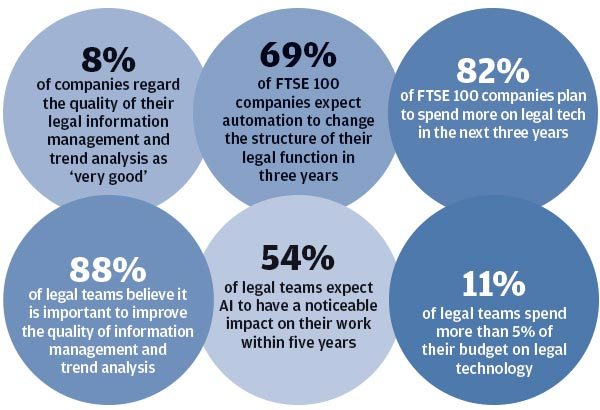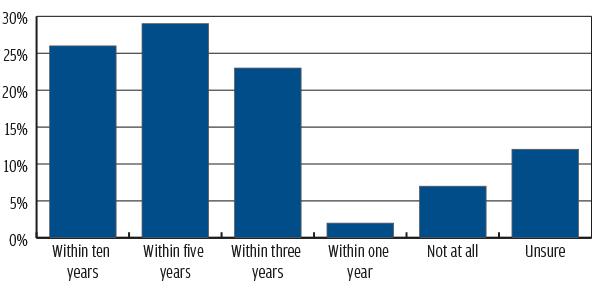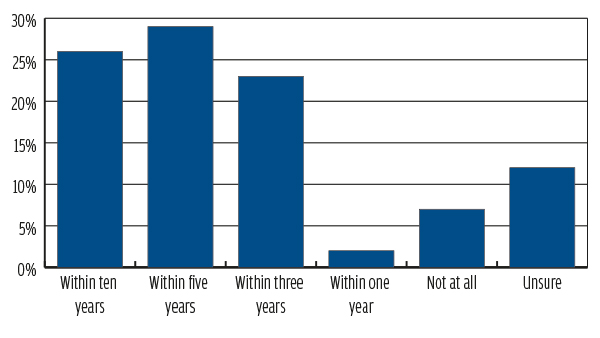If conventional law firms have been slow to embrace technology – and they have – their counterparts in-house have been barely moving. But in the last five years signs have emerged of ‘early adopters’ in the bluechip general counsel (GC) community who are willing to do more than apply new tools at the margins. The GCs are turning to technology to reshape the way they work.
Aside from the obvious efficiency benefits, the appeal to such GC pioneers is often more potent to the professional soul: control.
As Reckitt Benckiser’s vice president and GC Claire Debney comments: ‘I want the intellectual capital in-house, in my team. I don’t want to be outsourcing all of our supply agreements, distribution agreements, or our digital platform agreements. We want our people at the meetings and in the negotiations and have the external back-up if we need it.’
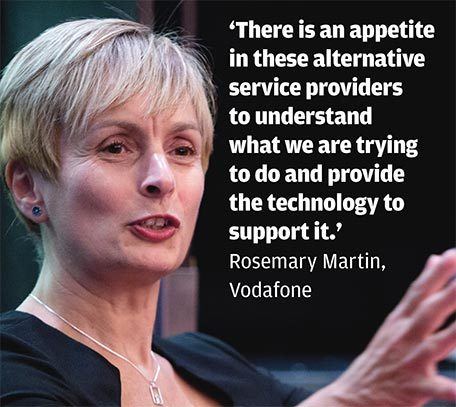
While there are GCs that fear the necessary changes associated with implementing new software and processes, some, particularly those from more tech-driven or heavily regulated sectors such as TMT, banking and life sciences, are using technology to reshape their own teams and operations. However, such overhauls do not come cheap and legal teams have often struggled to get heavy investment for IT and infrastructure.
‘The trouble with technology is it’s expensive and you need to remember you’re part of a business with an integrated information system. You have to make sure you optimise what you have. There are products out there that can help, not least by ensuring ready access to information,’ concedes Vivienne King, outgoing GC and director of business operations at The Crown Estate.
Nilema Bhakta-Jones, group legal director at media house Top Right Group, takes this point further: ‘Budgets are always challenged. You have to put together a business plan to support the capex spend. It is more likely to succeed if your plan demonstrates that tech improves cash flow, adds to revenue or creates efficiencies with those outcomes. For those organisations that are not focused on technological innovation, there will be little pressure on in-house legal teams to do so. Instead there may be reliance on external providers and private practice firms to provide cheaper tech solutions. Other in-housers want to innovate and will use technology as an enabler. They make it work for them; for example, they might use social media to communicate key messages, or use it to “beta” test a new legal portal that provides contracts management. It’s a choice for the legal head about how best to create operational efficiencies or engage with their business colleagues. Ultimately, it has to fit in with their, and their chief executive’s, vision and purpose.’
But there is a significant emerging group of GCs with ambitions to harness new tools. BAE Systems group GC Philip Bramwell sums up his goals for the next year: ‘Our biggest challenge is around the way we work as lawyers – this will be one of our themes for 2016. Lawyers now have no idea of life without the internet; there are electronic versions of the old paper world now. I’m making use of the newest devices and wireless technology. We’ve got to be better educated on managing [the] cyber security rise and inputting as crisis lawyers, while striving to keep abreast with changing law and regulation.’

‘Annually we have over 10,000 contracts just for our advertising business with a team of four lawyers doing it – it means the sales guys can put together some of their own contracts based on language the lawyers have provided and they can’t change it. They feel empowered, we know the language is safe. But they don’t have to wait for a lawyer to review their contract so the business moves faster; it’s less overhead. God, the profession is slow to pick up on technology – in private practice, appallingly slow.’
Reckitt Benckiser: getting the balance right
Reckitt Benckiser (RB)’s legal team, led by vice president and general counsel (GC) Claire Debney, who also heads up the legal affairs and compliance group, has been described as ‘a balancing act of risk and quality’ by peers. Some of this boils down to the team’s ability to embrace automated systems and adapt to new ways of working.
The group recently put into place the final component of its contract-management system – a compliance ‘sniff test’ that gives the lawyer an idea of what a contract is about based on a questionnaire comprising five questions around key areas of compliance, data protection and competition, integral to RB’s business. ‘With this added software, we can pick up stuff much earlier on, particularly on data protection,’ says Debney.
Under predecessor Bill Mordan – who recently stepped down from his senior vice president and GC post – the group pioneered a proprietary contract-management system i-Legal – a tool that enables clients to create their own contracts covering anything from non-disclosure agreements to supply agreements, without compromising legal certainty.
RB also teamed up with software provider Business Integrity to develop a cloud-based application, i-Contract, using ContractExpress. It offers flexible contract automation, contract management and archiving, and also allows RB to include its compliance strategy.
In 2014 the legal team generated over 1,000 contracts, of which less than 15% required direct legal approval. This directly reduced contract conclusion times. ‘We were drowning in contracts and needed to find a way to empower the business to take ownership of their own contracts, and come to us only when they needed to,’ says Debney.
‘I joke about how Tesco want to know what I want to buy before I buy it. We have data on all the contracts that are being completed and we can see patterns – where there is heavy usage – and we have created new contracts that people didn’t use three years ago. Who knew what cloud sourcing was three years ago?’
On average, Debney’s team alone pumps out between 600 and 700 non-disclosure agreements a year, and from this stems the potential of joint development agreements and supply agreements. ‘It becomes a contract family so the foundation is really key,’ she adds.
But while RB is setting the pace in the contract system world, e-discovery tools in general will take some time to gain traction. The company currently does not have any e-discovery manager tools, but uses accountancy firms like KPMG and Deloitte, which Debney describes as ‘exceptionally helpful’.
‘In a wholesale investigation I would return to a third-party provider. This is a big one-off event and wouldn’t be something we invest in, so we are happy to outsource as it’s not the day-to-day work where we could add value.’
In 2010, the Office of Fair Trading (OFT) fined RB £10.2m for infringing UK and EU competition rules on abuse of dominance, after it tried to protect its Gaviscon product from generic competition by creating an updated version of the drug and delisting the original product in order to extend the patent protection. The fine was reduced by £1.8m following RB’s co-operation and admission of liability under the OFT’s settlement programme.
‘RB did have several years of investigations and challenges that were common to the consumer products market in Europe,’ says Debney. ‘This is now behind us. We have moved from cure to prevention through these tools.’
In-house in order
Figures from technology research company CEB show that around three-quarters of in-house legal departments spend nearly a third of their time reviewing contracts. And as contract volumes continue to climb, automated contract management systems have unsurprisingly proved top of the priority list for GCs trying to implement better systems.
With its own system i-Legal, Reckitt Benckiser is ahead of many peers (see box, opposite). But Novartis has also embraced the concept and is seeing the benefits after moving away from years of storing documents locally to using a centralised electronic document management system in 2010, following a six-month pilot of the system. Because of its successful application, the same tech is currently being rolled out across the general legal function.

Meanwhile, Vodafone, for years one of the most innovative and tech-savvy legal teams in the industry, is currently getting alternative legal providers to pitch to extend the handling of contracts. Vodafone group GC and company secretary Rosemary Martin comments: ‘We are trying to get an end-to-end process around contracting with our business customers, handling the contract creation, execution of workflow, storage, retrieval and metadata, so we can manage those contracts in a very real and tight way.’
Martin, who notes it is alternative providers rather than law firms making the running in this area, adds: ‘I know that other corporates are trying to do the same thing. Our experience has been good so far. There is really an appetite in these alternative service providers to try to understand what it is that we are trying to do and then provide the technology to support it.’
Coca-Cola Enterprises (CCE) is in the early stages of rolling out a contract lifecycle management tool and this summer launched a five-year strategy to transform its internal systems following a consultation with legal management consultants Jomati. A new system for the creation and storage of contracts was implemented in the UK in May and launched in Europe four months later.
‘It’s a bit cart before the horse, because the first step is to run a technology need analysis and review what tech is out there and how it can help the business,’ says CCE vice president, legal and company secretary Paul van Reesch. ‘But when this is fully rolled out, it will allow people to generate a contract themselves or request a legal team to create it if it’s complex. This can then be sent to a customer and drafts can be exchanged using a negotiation portal. Internal approvals can be received and contracts can be signed electronically by both the customer and us, which can be stored electronically.’
CCE’s team of 30 lawyers is currently awaiting sign-off of the negotiation portal, approval process and electronic signature aspects. ‘This doesn’t mean we will abandon face-to-face meetings, but means we can exchange documents with customers,’ van Reesch adds. ‘We have sales people of all age groups that are often on the road and have time constraints. So how do you best leverage the traditional things and get the message or advice deeper into the business? This is what tech enables us to do: engage people on multiple platforms in multiple ways, with advice on the go without having to talk.’
Similarly, BT’s legal team is in the process of implementing a case-management system, having first showed its interest in the legal tech realm in 2012 when it acquired Tikit Group, one of the largest independent suppliers of technology and services to legal and accountancy firms, for around £64m.
BT’s GC for UK commercial legal services, Chris Fowler – a noted advocate of the use of tech in legal departments – says the advance of technology has been significant in the law.
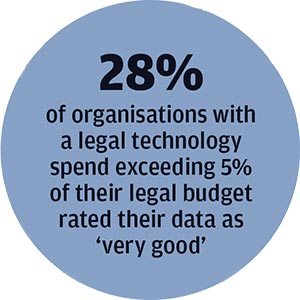
Similarly, Westfield’s 14-lawyer team, which has an external legal spend of around £7m to £10m a year, also signed a deal with NetDocuments early this year to implement its cloud-based software-as-a-service (SaaS) DMS.
But not all in-house teams can see the immediate benefits of investment in technology. Daniel Toner, GC and group company secretary at Spire Healthcare, comments: ‘We are looking at case-management systems but it’s not viable for us to get value compared to the cost. We have looked at artificial intelligence systems and looked at programmable logic controller systems, for example. I don’t see it having any interplay with our business. Reckitt Benckiser has a case-management system but it operates in 70 jurisdictions. A lot of what we do is bespoke. It will be a long time before we replace people with machines.’
Senior legal counsel David Johnson at First Gulf Bank agrees: ‘Producing new documentation quickly has been a struggle. Institutions across the world have moved from growth mode to cost-sensitive mode. You find external counsel who will work to almost any deadline you set, compete aggressively on pricing and do whatever is needed to secure transactions.’
Bank of Montreal: Optimum control
At the Bank of Montreal (BMO) Financial Group, deputy general counsel and chief knowledge officer Jolie Lin has been busy implementing tools in all three of the most popular areas for in-house legal technology development: contract management, e-discovery and e-billing.
In the past year, the 150-lawyer team has teamed up with Microsoft and rolled out an enhanced document-management system that allows better record keeping, increased efficiency and reduced costs.
Four years ago, the group started using e-discovery tools, and the result now is a 90% reduction in the number of documents sent to external counsel thanks to tools such as predictive coding and improved search.
In 2013, the group began using e-billing platform TyMetrix and introduced a new system to ensure contract process adherence. Lin says: ‘We wanted to have better control and management over our external counsel use. We wanted better clarity over spend and whether we can get more use. So we implemented a new platform just to manage this.
‘[The software] checks on rates and disbursements. Whatever the agreement was between us and the external counsel, the system flags all of that and ensures it doesn’t go through without people checking it.’
The automated systems, which cut out the manual review of every single invoice, have reduced the bank’s external legal spend by nearly 20%. Another turning point came when the team restructured its legal panel by dramatically cutting its go-to adviser list.
Lin, who also oversees BMO’s legal, corporate and compliance group, is currently working with Chicago-based software vendor KMStandards to build bespoke contract-creation tools that make legal work more efficient through the analysis of key terms. ‘It’s a tiny little shop that is turning out some really interesting stuff,’ says Lin. ‘A lot of companies say they are capable of conceptual search. They’re not even looking for key words anymore; they are looking for concepts. They’ve got the algorithm managed at a level where the machine can do it for you.’
She concludes: ‘This doesn’t mean the end of lawyers, but it certainly means there will be fewer lawyers.’
Tech bubbles
Key findings from our AI and automation survey:
A better generation
With many GCs frankly still wary of applying heavy automation and new processes in contract management, e-discovery and tech-backed litigation support has arguably seen more substantial change in the last five years. Novartis’ 500-strong legal team has in the last two years centralised a lot of its work around e-discovery, as well as implementing tools that have driven down costs and led to productivity savings of around $30m since 2011.

But while the Novartis team is now reaping the benefits, implementing the software and changing the mind-set of users can be challenging. ‘We didn’t think there was much work to do after the first year of implementing e-billing. But we had to learn quite a lot very quickly once the tech was in place,’ says Maurus Schreyvogel, head of operational excellence at Novartis. Unsurprisingly for a pharmaceutical giant with a significant patent portfolio, the benefits have been primarily felt in IP disputes, allowing business users to collaborate across different jurisdictions. ‘Tech gives us the freedom to assign work to people globally. We are now no longer forced into giving document discovery work to external firms. Instead, we can use e-discovery vendors around the globe. Using IT systems reduces costs from $130 to around $70 an hour,’ adds Schreyvogel.
Some in-house teams are using other methods to drive down costs. GlaxoSmithKline (GSK), for example, has a policy that requires all litigation or corporate work over £250,000 to go through an online auction process using the platform OCSI (online collection software instances), where law firms can bid for work.
‘The lowest bidder doesn’t always get the work,’ says senior counsel Tom Spencer. ‘It is the combination of the team, experience, relationship, and what else the firm is offering that is considered. These different scores will be weighted along with the bid and then a decision is made.’
But for all the talk of tech transforming legal departments, in-house teams still have a long way before they even get to deploying the knowledge-management tools that are already mainstream in some industries, let alone working with the cutting-edge AI.
But relatively slow change isn’t no change. E-billing, for example, has revolutionised the way some teams monitor legal expenditure, with companies like Novartis and the Bank of Montreal (BMO) (see box) making substantial savings, and has won support for data analytics.
Tyco International uses e-billing tracker Serengeti to monitor all its external legal spend. It also this year introduced an online system for generating non-disclosure agreements. But vice president and regional GC of EMEA David Symonds says that while the systems ‘take the work off our desks, beyond that, we’re not very far along in the use of tech in our legal department’.
CCE’s van Reesch sums up: ‘It’s not about trying to automate 50% of our legal work but about getting the right balance with human interaction while moving with the times. In five to ten years, we will see more millennials coming through and we need to engage with these people.’
As tech continues to evolve, it is important GCs liaise with the right providers. BMO Financial Group deputy GC Jolie Lin comments: ‘Providers outpace and leapfrog each other all the time, so you have to re-consider your providers every three to five years. I am a little vendor-agnostic. Different platforms can do different things and are rarely the only provider that can do it.’
Debney adds: ‘I like the smaller companies that think out of the box and are happy to partner with us. We like to take solutions and slightly torture them by saying, “That’s a great starting point; can we have some more?” I like to take it as a platform and then ask the provider – “Are you happy if we tinker with it?”’
She compares her team’s progress with private practice when she says: ‘Compliance, contracts and learning are all interlinked, and should not be siloed, because you will create a better generation of lawyers that are able to deliver services in an incredibly streamlined way. We are going to leave private practice in the dust.’
AI and advanced automation – the clients’ view
Over half of legal teams expect automation to have a significant impact on the way they work in next three years…
As part of this special report, Legal Business last month canvassed general counsel (GCs)and decision-makers on their views on the current uses and prospects for AI and advanced automation in the law.
The results of the survey – which generated over 600 responses – are clear: in-house teams expect the automation of legal services to significantly change the way they work in the next three years. More than half of legal teams believe the impact will be ‘significant’ or ‘very significant’, while only 3% believe automation and new technology will have no impact at all.
Larger organisations are considerably more attuned to new tech-driven tools; 69% of FTSE 100 companies surveyed believe workflow automation and IT will change the way their legal function is structured in the next three years.
AI will change the way legal teams work, it’s just a question of when…
In-house teams also believe AI-based systems will materially transform the way they provide support to business in the near-term. But while legal teams are unanimous that AI will have an impact there are widely differing views as to the speed of change.
In what time frame, if at all, do you believe that advances in artificial intelligence will have a noticeable impact on the way legal support is provided by your function to your business?
How do you rate the quality of management information and trend analysis data that you have in your legal function?
Only a third of organisations rate the quality of their legal data as above satisfactory…
If legal teams think a change is coming, they also see a need for it; many rate their current systems and practices as average.
Only 8% of respondents rated the information management and trend analysis data of their legal function as ‘very good’. For those occupying senior legal positions – GCs, heads of legal, and company secretaries – this figure fell to around 5%. Senior legal staff were also more likely to rate the quality of information and data management as ‘poor’ or ‘very poor’. More than a quarter of respondents felt quality was ‘poor’ or ‘very poor’, while 39% rated it as ‘satisfactory’.
Legal teams also think more needs to be done in this area; 88% of teams said it was important to improve the quality of management information in their function.
There was a wide variation in response across market sectors and company sizes. Logically, one would expect companies with lower legal budgets to spend proportionately more on expensive technological systems, but this was not the case. Companies with a legal budget between £5m and £10m were over three times more likely to spend more than 5% of their budget on technology as those with budgets of £500,000-£5m.
Those that spend a higher proportion of their legal budget on technology were significantly more likely to report confidence in existing systems and practices: while 28% of organisations spending more than 5% of their budget on legal technology rate their data as ‘very good’, only 6% of those spending around or below 5% on technology are of the same opinion. Conversely, only 6% of organisations with a legal technology spend exceeding 5% of their legal budget rated quality of systems and processes as ‘very poor’, a figure that rose to 26% of those who spent less than 5% of the budget.
But investment is not a guarantee of success. Media companies were the joint-highest spenders on legal tech, with over a quarter dedicating more than 5% of their budget to it. They were also among the least satisfied with existing systems, with only 6% rating them as ‘very good’, though this may indicate higher expectations. Conversely, public sector organisations were the second-lowest spenders on legal technology, but their legal teams showed the most confidence in existing systems; while 56% of public sector organisations were in the lowest-spending bracket for legal technology, 22% rating their systems as ‘very good’ (a positive rating that was over twice the average across all market sectors).
Legal tech budgets set to increase…
Big spenders on legal technology remain in the minority. Only 11% of teams spent more than 5% of their budget on legal technology, compared to 44% spending less than this (the balance of respondents either spend around 5% or were unsure). While confidence in existing systems was generally low across all sectors, there are signs of change. More than two thirds (74%) of legal teams expect to spend more of their budget on legal technology over the next three years.
Again, larger organisations are at the forefront: 82% of FTSE 100 companies, 66% of FTSE 250 companies and 69% of Fortune 500 companies say they will spend more on legal tech in the coming three years. This resonates with the views of many of the academics, third-party suppliers and technologists we interviewed. Despite the often invoked model of disruptive innovation put forward by Clayton Christensen, which suggests smaller or marginal clients initially support disruptive market entrants, in law it is larger institutional clients, which are far more frequent users of legal services, that are the most receptive to tech-assisted tools and new models of working.
For the full report published by Legal Business, please see: ‘AI and the law tools of tomorrow: A special report’

